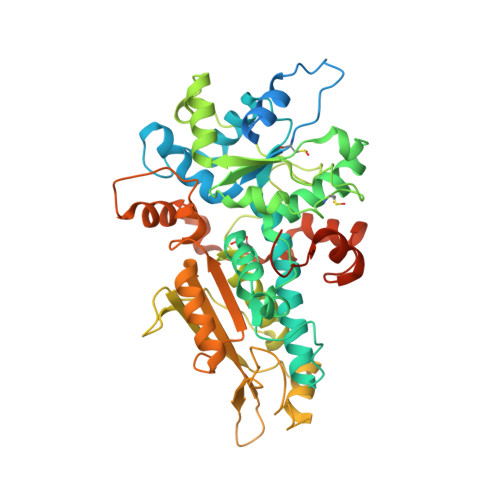[FeFe]-Hydrogenase Oxygen Inactivation Is Initiated at the H Cluster 2Fe Subcluster.
Swanson, K.D., Ratzloff, M.W., Mulder, D.W., Artz, J.H., Ghose, S., Hoffman, A., White, S., Zadvornyy, O.A., Broderick, J.B., Bothner, B., King, P.W., Peters, J.W.(2015) J Am Chem Soc 137: 1809-1816
- PubMed: 25579778
- DOI: https://doi.org/10.1021/ja510169s
- Primary Citation of Related Structures:
4R0V - PubMed Abstract:
The [FeFe]-hydrogenase catalytic site H cluster is a complex iron sulfur cofactor that is sensitive to oxygen (O2). The O2 sensitivity is a significant barrier for production of hydrogen as an energy source in water-splitting, oxygenic systems. Oxygen reacts directly with the H cluster, which results in rapid enzyme inactivation and eventual degradation. To investigate the progression of O2-dependent [FeFe]-hydrogenase inactivation and the process of H cluster degradation, the highly O2-sensitive [FeFe]-hydrogenase HydA1 from the green algae Chlamydomonas reinhardtii was exposed to defined concentrations of O2 while monitoring the loss of activity and accompanying changes in H cluster spectroscopic properties. The results indicate that H cluster degradation proceeds through a series of reactions, the extent of which depend on the initial enzyme reduction/oxidation state. The degradation process begins with O2 interacting and reacting with the 2Fe subcluster, leading to degradation of the 2Fe subcluster and leaving an inactive [4Fe-4S] subcluster state. This final inactive degradation product could be reactivated in vitro by incubation with 2Fe subcluster maturation machinery, specifically HydF(EG), which was observed by recovery of enzyme activity.
Organizational Affiliation:
Department of Chemistry and Biochemistry, Montana State University , Bozeman, Montana 59717, United States.



















